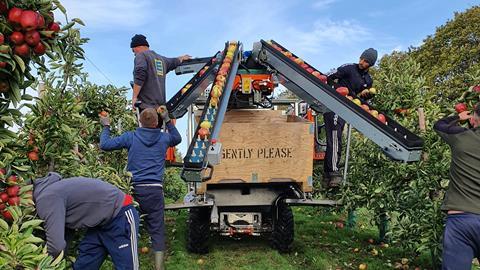James Simpson, managing director of Adrian Scripps, tells FPJ how the major Kentish apple producer is innovating in the face of big challenges this season
How worried are you about labour shortages this coming season?
While the ability to source local labour is still a huge concern, the UK apple industry will benefit from the increased number of seasonal worker permits this year. We are delighted the government has seen this as essential for the viability of the horticultural sector.
Initial numbers looked low, as the lateness of the government’s decision on the increased availability of permits meant providers initially struggled to source labour. We are pleased that as the season has progressed, labour has become more readily available. This is, in part, being helped by the harvest periods of other crops freeing up labour to move to topfruit earlier.
We expect to have enough labour this year. We have invested heavily in mechanisation of our harvesting over the past two seasons. This has had the benefit of improving productivity and staff wellbeing, as well as increasing staff earning capacity. The combination of these factors has seen our number of returnees increase significantly, while also reducing our labour requirement.
How are you automating the picking process to boost efficiency and reduce reliance on manual labour?
We have invested in a fleet of harvesting platforms from Revo of Italy. The self-propelled, auto-steering platforms have conveyors for pickers to directly place apples on, which then automatically fill the fruit bin. This removes the need for traditional over-the-shoulder picking buckets or bags and places the staff next to the machine. Staff are not walking and carrying fruit, and the efficiency is significantly improved.
Which other technologies are helping apple growers improve their efficiency and sustainability?
We are employing technology to measure blossom density, tree vigour and crop yield. We are able to link the mapping produced from the images directly to our machinery fleet, allowing variable rate application of plant protection and nutrition products. We have drones, tractor-based and harvester-based camera technology measuring tree health and crop yield.
There are several very promising pieces of technology that we are using for the first time this year. Harvester-based yield recording through fruit imaging, counting and sizing will be key to giving size profiling of the orchard as it is harvested.
We are also introducing air purification systems to some of our controlled atmosphere stores, using equipment to remove fungal, bacterial and viral contaminants from the air within the apple stores. In trials, we have seen a significant uplift in fruit quality and a reduction of waste in store.
How is 2022’s hot, dry weather affecting production?
The hot weather has been a major factor in slowing fruit growth. Trees tend to shut down in excessively warm temperatures, slowing fruit size development. We have trickle irrigation across all orchards, which helps but does not replace decent levels of rainfall.
What we are expecting is good texture, flavour and sugar levels. We have seen higher levels of sunburn on fruit and have had to restrict working in orchards where both staff and fruit suffer in the sun.
Availability of water is key, and we will be reviewing our reservoir capacity across all sites to ensure we have more than adequate availability of water in the future. Shade protection, which is provided by hail netting on some orchards, may also be a consideration, but is less of a priority at the moment.
How is inflation affecting your business, and how are you managing it?
Labour inflation is significant, the government-dictated 15 per cent increase in labour rates puts the horticultural minimum wage above any other sector or industry in the UK. This comes after a combined increase in our wage cost of over 35 per cent over the past 4-5 years. Labour cost is the single largest expense to most fruit businesses.
Packaging, power, haulage and almost every cost is increasing to such an extent that we have seen the cost of production rise by 10-14 per cent across the business. We appreciate the supply chain is seeing similar rises and are grateful for the support some retailers have given suppliers in increasing prices.
Which apple varieties are showing the most promise in the UK market at the moment and why?
There are challenges across the sector with varieties. Commodity varieties for a range or reasons are not delivering the returns growers need to continue to invest in orchards of Gala or Braeburn, for example. The problem for growers is to find an established alternative that has an immediate place in the market.
For too many years, marketing desks and nursery breeders have steered growers to varieties that fail to establish a foothold or premium. Pink Lady have succeeded across the world in creating demand for a quality apple that returns financially for the grower. We are investing in Pink Lady, but I couldn’t tell what variety the next investment should be in.
Do you plan to send more apples to LuLu hypermarkets in the Middle East this season, and do you have any other export plans?
Our relationship with Lulu and Growers Direct has built up a large export business that we intend to keep developing. There are continuing opportunities to export and build volume.
Markets outside of the Middle East will become more of an area for us to develop. This will require government support to open up some locations.
Where do you see opportunity for UK apple growers this season?
Apples as a category has seen a level of decline. The challenge for growers and suppliers is to find mechanisms to support retailers to increase interest and demand in the topfruit category. Whether this is at the premium end of the market or at the value end, consumers are looking for value for money.




